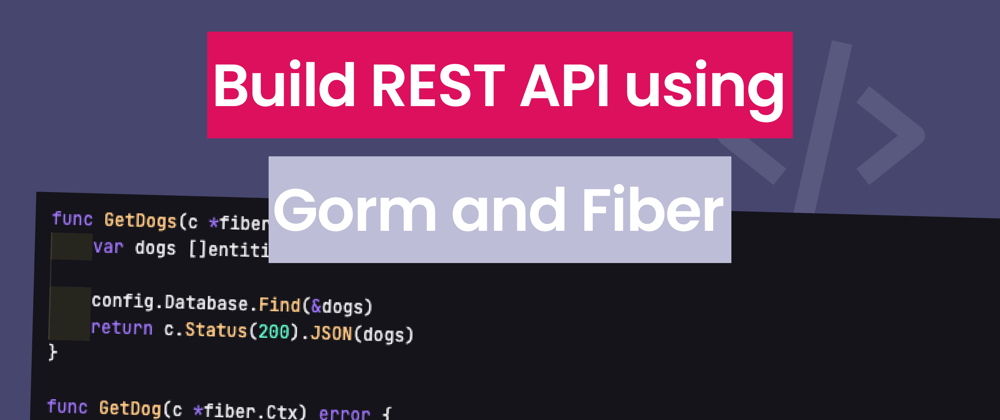Overview
In the past I have written several articles about how we can interact with relational databases, however they were all for the JavaScript and TypeScript community. So this week I will share with you how we can create a simple API and perform a CRUD on a specific table in our database, this time in Go.
In this article, as in other articles I've written in the past in Golang, we'll use the Fiber framework, it's quite simple to use, has a good abstraction layer and contains everything we need to create our API.
Regarding the interaction with the database, I decided to use an ORM to make the whole process simpler and more intuitive and for that reason I decided to use Gorm, which in my opinion is the most popular ORM in the Go universe and has a great range of features.
Let's code
In today's example we are going to install only three dependencies, which are as follows:
go get github.com/gofiber/fiber/v2
go get gorm.io/gorm
go get gorm.io/driver/mysql
As you may have noticed, in this example I installed the MySQL driver because the database I have running in a docker container is MariaDB, however there are also drivers available for PostgreSQL and SQLite.
Now let's start by defining our Entity, which will have a total of four properties:
-
Name- the name of the dog -
Age- the age of our four legged friend -
Breed- our friend's race -
IsGoodBoy- whether our friend has been a good boy or not
Similar to the following:
// @/entities/dog.go
package entities
import "gorm.io/gorm"
type Dog struct {
gorm.Model
Name string `json:"name"`
Breed string `json:"breed"`
Age int `json:"age"`
IsGoodBoy bool `json:"isGoodBoy" gorm:"default:true"`
}
Now we can proceed to the configuration of the connection with the database. In this case I like to create a function called Connect() that will be responsible for initializing the connection, besides that it will also be responsible for performing the migrations in our database. This way:
// @/config/database.go
package config
import (
"github.com/FranciscoMendes10866/gorm/entities"
"gorm.io/driver/mysql"
"gorm.io/gorm"
)
var Database *gorm.DB
var DATABASE_URI string = "root:root@tcp(localhost:3306)/gorm?charset=utf8mb4&parseTime=True&loc=Local"
func Connect() error {
var err error
Database, err = gorm.Open(mysql.Open(DATABASE_URI), &gorm.Config{
SkipDefaultTransaction: true,
PrepareStmt: true,
})
if err != nil {
panic(err)
}
Database.AutoMigrate(&entities.Dog{})
return nil
}
Now that we have our Entity defined and the connection to our database configured, we can start working on our handlers. Each of our handlers will correspond to a route from our API, so each one will be responsible for executing only one operation. First let's get all the records we have in our database table.
// @/handlers/dog.go
package handlers
import (
"github.com/FranciscoMendes10866/gorm/config"
"github.com/FranciscoMendes10866/gorm/entities"
"github.com/gofiber/fiber/v2"
)
func GetDogs(c *fiber.Ctx) error {
var dogs []entities.Dog
config.Database.Find(&dogs)
return c.Status(200).JSON(dogs)
}
// ...
Now let's get just one record according to the id parameter that will be sent in the request parameters.
// @/handlers/dog.go
package handlers
// ...
func GetDog(c *fiber.Ctx) error {
id := c.Params("id")
var dog entities.Dog
result := config.Database.Find(&dog, id)
if result.RowsAffected == 0 {
return c.SendStatus(404)
}
return c.Status(200).JSON(&dog)
}
// ...
Now that we can get all the records and also just one record. We lack the functionality to insert a new one in the database table.
// @/handlers/dog.go
package handlers
// ...
func AddDog(c *fiber.Ctx) error {
dog := new(entities.Dog)
if err := c.BodyParser(dog); err != nil {
return c.Status(503).SendString(err.Error())
}
config.Database.Create(&dog)
return c.Status(201).JSON(dog)
}
// ...
We still need to add the functionality to update an existing record in our database. And similar to what we've already implemented, let's use the id parameter to update the specific record.
// @/handlers/dog.go
package handlers
// ...
func UpdateDog(c *fiber.Ctx) error {
dog := new(entities.Dog)
id := c.Params("id")
if err := c.BodyParser(dog); err != nil {
return c.Status(503).SendString(err.Error())
}
config.Database.Where("id = ?", id).Updates(&dog)
return c.Status(200).JSON(dog)
}
// ...
Last but not least, we need to delete a specific record, again we will use the id parameter to remove the specific record from our database.
// @/handlers/dog.go
package handlers
// ...
func RemoveDog(c *fiber.Ctx) error {
id := c.Params("id")
var dog entities.Dog
result := config.Database.Delete(&dog, id)
if result.RowsAffected == 0 {
return c.SendStatus(404)
}
return c.SendStatus(200)
}
// ...
Now we just need to create our main file that will be responsible for initializing the connection to the database and where our API routes will be defined and a handler will be associated to each one of them.
// @/main.go
package main
import (
"log"
"github.com/FranciscoMendes10866/gorm/config"
"github.com/FranciscoMendes10866/gorm/handlers"
"github.com/gofiber/fiber/v2"
)
func main() {
app := fiber.New()
config.Connect()
app.Get("/dogs", handlers.GetDogs)
app.Get("/dogs/:id", handlers.GetDog)
app.Post("/dogs", handlers.AddDog)
app.Put("/dogs/:id", handlers.UpdateDog)
app.Delete("/dogs/:id", handlers.RemoveDog)
log.Fatal(app.Listen(":3000"))
}
Conclusion
As always, I hope you found it interesting. If you noticed any errors in this article, please mention them in the comments. 🧑🏻💻
Hope you have a great day! 🚨







Oldest comments (7)
Why importing local packages as github.com/FranciscoMendes10866/gorm ?
It's just a preference of creating/initializing the project/module (I have an idea that it's quite common in the community) 🌵 But I prefer it to be something simpler, like "rest-api" 🤓
This is a great resource; especially that it's up to date
Thank you for this
Cool
did you try Golobby ORM?
Why database connection was not closed?
It will close automatically when the server is stopped. If we were to create a new database connection for every operation it will take unnecessary time. What most do is create the connection at the start of the server and share that connection across all CRUD operations.
This is the best tutorial on building rest api with golang i've seen so far